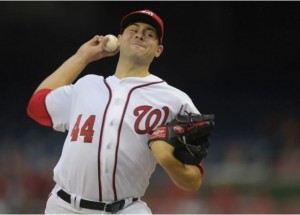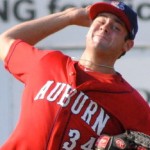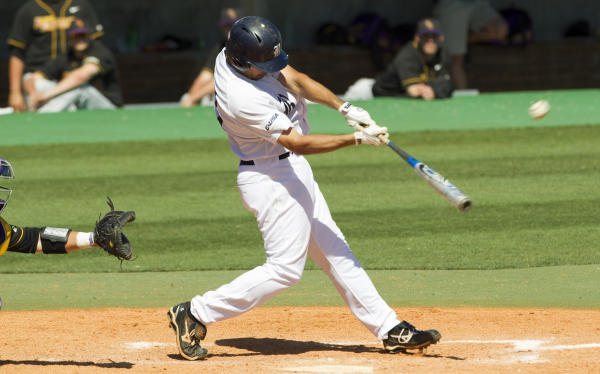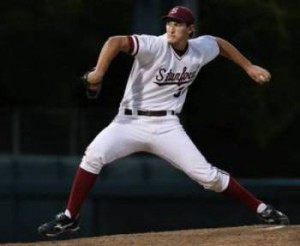Fifth in our set of Draft class Reviews for the 2016 season. First was the 2016 class, then the 2015 class then the 2014 class, then the 2013 class.
Web links to use while reading:
- Stats are pulled from milb.com and/or fangraphs.com; put the player name into the search bar to get his seasonal stats
- The 2016 MLB.com Draft Tracker (which I believe is the best draft tracker out there) is the best place to get draft class information.
- The 2016 Bonus Tracker
- The Big Board and the Draft Tracker are the goto resources for prospects for any Nats fan.
- More obscure stats on players are sometimes found at places like thebaseballcube.com, perfectgame.org, their college websites, twitter accounts for the players, and good old fashioned deep-dive googling.
- My historical list of Nats prospect rankings, updated for all 2016 mid-season rankings.
This review is especially important to follow because the high-school age draftees in this 2012 class are Rule-5 eligible this coming off-season. Not that there’s that many of them, but we’ll put a pin in this post when we eventually do Rule-5 Analysis later this month.
With out further ado…
Round 1: (#16 overall) Lucas Giolito HS RH Starting pitcher: 6.75 ERA in 21 1/3 MLB innings, 6-5 with a 2.97 ERA mostly in AA but with 7 starts in AAA. 116/44 K/BB in 115 1/3 minor league innings. I feel, much like the 2016 presidential election, that most of us are girded in our opinions on Giolito at this point. I think Giolito’s entire season was tainted by the stories of mechanical tweaks done by some ne’er-do-weller in Viera, and his results on the field showed. He struggled with command and hit-ability during his brief time with the MLB team, and his velocity was down from where we were “expecting” it to be. Its important to remember that he just turned 22, that he lost a significant amount of development time because of his TJ surgery, and that we should be patient. But he definitely has a “todo list” for 2017. I’m projecting that he starts in AAA until he proves that he can command his fastball. Matriculated to Majors. Post-writing update: Giolito headlined a trade for Adam Eaton, heading to the White Sox. On his way out the door, word was leaked to multiple reporters that the Nats had “soured” on Giolito, questioning his toughness and his ceiling. Luckily for Giolito, the White Sox pitching coach (Don Cooper) is quite well regarded, so if there’s someone out there that can “fix” whatever’s wrong with him, its Cooper. I’ve updated the summary for his departure, which significantly thins this draft class.
Round 2: (80) Tony Renda, Coll Jr 2B: Traded to the Yankees on 6/11/15 for David Carpenter. Renda then was included in the package that the Yankees sent to Cincinnati for Aroldis Chapman. For Cincinnati, Renda got 67 ABs this year and hit .183. Post-writing update: hat tip to commenter KW, Renda was outrighted to AAA earlier this month. He may have matriculated to the majors, but its safe to classify him as a AAA-ceiling player now.
Round 3: (111) Brett Mooneyham, Coll Jr LH starting pitcher: Released him on 6/3/15.
Round 4: (144) Brandon Miller Coll Sr Corner OF: Voluntarily retired on 7/10/15.
Round 5: (174) Spencer Kieboom, Coll Jr C: Slashed .230/.324/.314 in 309 ABs for AA Harrisburg. 61/43 K/BB in 94 games splitting time behind the dish, 5 homers, 0 SB. Kieboom didn’t have the best numbers hitting in AA; he’s known for his defense. He became the final nats 40-man call-up when Wilson Ramos tore his ACL and got exactly one MLB at-bat (and thus permanently qualifying him for the MLB health plan for the rest of his days). He’s a catcher on the 40-man roster; he’s going to play in 2017. The question is where; right now depending on whether the team acquires another catcher, Pedro Severino may get pushed back to AAA, which may very well keep Kieboom in AA starting. Only makes sense. But if the team decides to keep Severino up, then Kieboom moves up too. Trending steady. Post-writing update: the team went and acquired Derek Norris, which now pushes Kieboom to 4th out of 4 on the depth chart, almost guaranteeing that he’ll be in AA again (you can’t have both Severino and Kieboom splitting time in AAA; that makes no sense). I don’t think this necessarily changes his projection, since Jose Lobaton hits so poorly, but he does have to climb over Severino if he wants to matriculate permanently.
Round 6: (204) Hayden Jennings, HS OF/CF: Released in May 2014.
Round 7: (234) Robert Benincasa, Coll Jr. RH relief pitcher: 1-1 with a 4.50 ERA in 21 appearances and 30 relief innings for AA. 35/14 K/BB in 30 IP, 1.50 whip, 4.69 fip, .329 babip for AA. Benincasa threw a few outings in Potomac but we’re just focusing on AA numbers here. He repeated AA for the third successive season and had good K/9 numbers but not much else in support. I’m guessing he sticks around for one more season, likely in the AAA bullpen, and plays out the 6-year string before hitting MLFA after next season. Unless he runs into a numbers game; there’s likely at least three 40-man roster guys that will get pushed to the AAA bullpen, limiting jobs for org-arms like Benincasa. He could be a release candidate before the full season squads break next spring. Trending down.
Round 8: (264) Stephen Perez, Coll Jr. SS: Slashed .249/.351/.342 playing middle infield for Harrisburg. 59/47 K/BB in 301 ABs, 5 homers, 12SB. Perez was a Ben Zobrist-like player for AA, getting PT at all four infield positions plus left field. His slash figures were definitely an improvement over prior seasons, and may have stabilized his chances of moving up. All of the middle infielders for AAA this year are FAs (I believe) so there’s room for him to move up. I don’t view him as anything other than an org-guy though, and (like Benincasa above) seems likely to play out his contract and hit MLFA next season. Trending Steady.
Round 9: (294) Derek Self, Coll Sr. RH relief pitcher: 4-2 with a 4.10 ERA mostly with AA Harrisburg. 43/18 K/BB in 52 2/3 innings, 1.48 whip, 3.98 whip, .333 babip. Self started the year briefly in Potomac’s bullpen but quickly returned to AA, where he spent most of the year. He got a 9/1 call-up to fill a bullpen spot in AAA. He improved his ERA over last year’s AA session and continues to hang on despite his lack of draft pedigree. I don’t see that he’s earned a promotion to AAA, and with a potentially packed AAA bullpen he may be back in AA again or to be a release candidate at this point. He turns 27 in January; I think the team knows what they have with him by this point. Trending down.
Round 10: (324) Craig Manuel, Coll Sr C: Released 4/2/16 after (presumably) failing to win the backup catcher job at either Potomac or Harrisburg. Time ran out for the locak product (born in Rockville, MD).
Round 11: (354) Brian Rauh, Coll Jr RH starter/reliever: Missed the entire 2016 season due to injury. Borrowing from last year’s analysis, if he’s healthy expect him to contend for the AA rotation in 2017. If he’s not healthy, he’s a release candidate at this point. Trending down.
Round 12: (384) Carlos Lopez, Coll Sr 1B: Released on 6/30/15.
Round 13: (414) Elliott Waterman, Coll Jr LH reliever: Released on 3/15/14
Round 14: (444) Jordan Poole, Juco-2 corner OF: Released him on 3/14/14
Round 15: (474) Brandon Smith, OF: Didn’t sign. Attended Division II Grand Canyon University, where he played four years. He hit a robust .348/.402/.478 as a junior but wasn’t drafted, then slumped to hit just .233 his senior year. Again not drafted, might be done with baseball.
Round 16: (504) Ronald Pena, Juco-2 RH starter/reliever: threw just 8 innings for Low-A Hagerstown before hitting the D/L in late April; he got another few innings in GCL rehab sessions but it was a lost season for Pena. I’d say he’s a release candidate unless the team likes something they see, but he’s now thrown just 18 innings in two seasons and the two A-ball full season squads seem pretty full. Trending Down.
Round 17: (534) Blake Schwartz, Coll Sr RH Starting pitcher: Retired on 4/24/15.
Round 18: (564) David Fischer, Coll Sr RH reliever: Released on 7/3/14
Round 19: (594) Bryan Lippincott, Coll Sr 1B: Retired ahead of the 2014 season
Round 20: (624) James Brooks, Coll SR SS/3B: Released May 2013.
Round 21: (654) Austin Chubb, Coll Sr C: Released ahead of the 2015 season.
Round 22: (684) Will Hudgins, Coll Sr RH reliever: Suddenly retired 7/12/13 per his Twitter account.
Round 23: (714) Casey Selsor, Coll Sr LH Starter/Reliever: Released on 3/20/14.
Round 24: (744) Kevin Dicharry, Coll SR RH pitcher: released 7/1/13
Round 25: (774) Freddy Avis, RHP: didn’t sign. Attending Stanford, where in 2013 he appeared in exactly one game and pitched 2 innings before suffering a season-ending injury. That injury never got better and he retired from baseball altogether in March of 2015.
Round 26: (804) Skye Bolt, RHP: didn’t sign. Attended UNC, had an excellent college career and was a 4th round pick in 2015 by the Oakland A’s. Hit .231 for Oakland’s low-A team this year.
Round 27: (834) Cody Poteet, RHP: didn’t sign. Attended UCLA and got drafted (like Bolt) in the 4th round of the 2015 draft by the Marlins. Was 4-9 with a 2.91 ERA starting in the Sally league this year.
Round 28: (864) Hunter Bailey, Coll Sr SS/2B: Released May 2013.
Round 29: (894) Leonard “LJ” Hollins, Juco RH reliever: Released 7/2/14.
Round 30: (924) Robert “R.C.” Orlan Coll Jr LH Starter: 5-6 with a 3.93 ERA relieving and sometimes closing for High-A Potomac. 46/46 K/BB ratio in 52 2/3 innings (no, that wasn’t a typo). 1.61 whip, 5.16 fip, .250 babip. I’m not quite sure what happened to Orlan’s control, since it looked just fine in 2015 (85/28 K/BB ratio in 72 relief IP). The Virginia product (UNC by way of Deep Run HS in Glen Allen, VA) definitely needs to get his walks under control to keep moving up, but is a potential lefty reliever in a system that could use one. I’ll say Trending Steady and project him for the AA bullpen.
Round 31: (954) Michael Boyden Coll Sr RH reliever: Released Jan 2014.
Round 32: (984) Michael Mudron, Coll Sr LH reliever: Released Jan 2014.
Round 33: (1014) Mike McQuillan, Coll Sr 2B/3B: Released 3/26/15.
Round 34: Jake Jefferies, 2B: didn’t sign. Attended Cal State Fullerton and subsequently drafted again by the Nats in the 39th round in 2015. As we found out in our 2015 post, he was released in July 2016.
Round 35: Corey Bafidis, LHP: didn’t sign but Washington picked him in 2013. As we learned in the 2013 post, he got released in July 2014.
Round 36: Max Ungar, C: didn’t sign. Went to the Charles E Smith Jewish Day school in Bethesda and attended Division III Denison, where he did seem to ever play. A quick google search found him on linkedin; he graduated in 2016 and now works in the DC area. I’ll venture a guess that this was a “favor pick” to someone with ties to the organization.
Round 37: Tyler Watson, LHP: didn’t sign. Attended Kansas U for a year, then bounced to McLennan Community College in Waco, TX and and got drafted by the Angels in the 38th round of the 2014 draft. He had a 3.42 ERA for the Angels’ low-A squad in 2016. This is *not* the same Tyler Watson, by the way, that the Nats drafted in the 2015 draft.
Round 38: Jarred Messer, RHP: didn’t sign. Graduate from Malone college and has pitched the last three years with the Kansas City T-Bones in the independent American Association, going 4-5 in 2016.
Round 39: Mitchell Williams, C: didn’t sign. Attended the Marion Military Institute in Alabama, for which I cannot find any stats.
Round 40: Ricky Gutierrez, CF: didn’t sign. Presumably playing football for U-Conn, as per the Draft Tracker.
Trending Summary:
- Matriculated to Majors: (2); Giolito, Renda
- Trending Up (0):
- Trending Steady (3): Kieboom, Perez, Orlan
- Trending Down (4): Benincasa, Self, Rauh, Pena
- Did Not Sign in 2012 (11): Smith, Avis, Bolt, Poteet, Jefferies, Bafidis, Ungar, Watson, Messer, Williams, Gutierrez
- Released/Retired (20): Mooneyham, Miller, Jennings, Manuel, Lopez, Waterman, Poole, Schwartz, Fischer, Lippincott, Brooks, Chubb, Hudgins, Selsor, Dicharry, Bailey, Hollins, Boyden, Mudron, McQuillan
- Traded (2): Renda, Giolito
Executive Summary
We have speculated that this would be a one-player draft, and we’re getting closer to that reality. Only Giolito is “succeeding” right now, and there’s rather fierce debate about his “ceiling.” Renda technically has matriculated to the majors as well, but his .183 BA there isn’t exactly all-star calibre (and he was just outrighted, meaning he may be downgraded to “peak before majors” in future versions of this post). Kieboom is on the 40-man roster but is 3rd out of 3 4th out of 4 on the Nats Catcher depth chart and may not even play in AAA next year. The only other two guys remaining from this draft class even projected to be trending steady are both clearly org-guys who are playing out the string (Perez, Orlan). Of the 8 remaining players from this draft, Giolito is on the 40-man and no one else merited any discussion for Rule 5 protection this coming December.
If there was some complaint about the 2013 draft class … then how do you feel about this one? I remember arguing in this space about whether a one-man draft could be a success if that one player was a perennial all-star (as Giolito projected to be for a while) and there was differing opinions on the subject. Well, now that there’s questions about what Giolito will eventually be, now how do you feel about this draft class?





